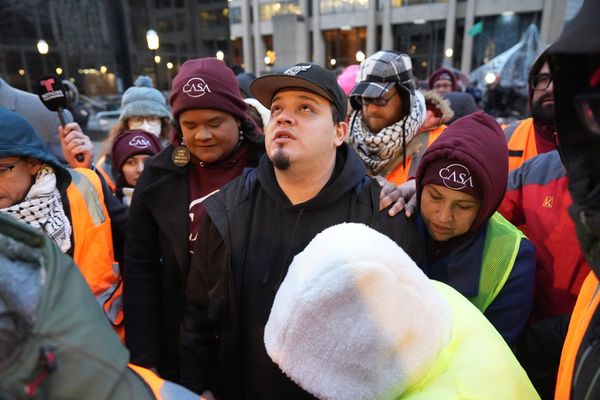
Like anyone else, every now and again I come across old photos of family holidays. There are quite a few from the mid-1970s, mostly taken on Bournemouth beach. Obviously, I look at the faces of my parents, now gone, or of me and my sisters – but sometimes I find myself focusing on the other holidaymakers in the background, in their own deckchairs or building their own sandcastles: strangers who, by chance, were caught by our camera and preserved for ever.
There is something of that sensation – the random serendipity of the tourist’s lens – at work in a mesmerising new film called Three Minutes: A Lengthening. It runs for just over an hour, and yet all the images you see come from the same three (or nearly four) minutes of amateur, home-movie footage – those 200-odd seconds of cine film played in full once at the beginning and once again at the end. In between, sequences are played backwards or forwards, sometimes slowed down, sometimes freeze-framed. We zoom out and zoom in. Some frames are magnified to such an extent that what we see is a kind of microscopic blur. The original three-minute film was shot with barely a thought, by an American man on vacation in Europe decades ago, but this new documentary invites us to stare with rare intensity at the people who happened to find themselves in front of his lens.
We do so because of when and where it was shot. For the man with the camera was a New Yorker visiting Poland in August 1938 and he took the film in Nasielsk, a small town about 30 miles north of Warsaw. The people he photographed were Nasielsk’s Jews, who made up nearly half the town’s population, and who, like the rest of Europe’s Jews, would soon be sentenced to death by the Nazis. It means that almost every face you look at – every bearded old man, every mother in a scarf, every daughter in plaits, every woman in a housecoat, and every boy grinning and waving at the camera – is someone who, in the following year, would be shipped out of Nasielsk and confined to a ghetto and then, three years after that, taken from the ghetto to the death camp of Treblinka, where they would be gassed.

The film very nearly disappeared. It had been shot by David Kurtz – who had himself been born in Nasielsk, before emigrating to the US in the late 19th century – during a grand tour of Europe, and had been left in a closet in Palm Beach Gardens, Florida. It was found there by Kurtz’s grandson, Glenn, in 2009. He had discovered it just in time. Expert restorers said that, had he brought it to them even one month later, it would have been too late. The celluloid was shrivelling, shrinking, cupping and buckling, succumbing to a menace known as “vinegar syndrome”. As it was, they were able to rescue it from oblivion and put it on the United States Holocaust Memorial Museum website; Kurtz wrote a book – Three Minutes in Poland – about the experience, published in 2014.
A Dutch film critic and historian, Bianca Stigter, chanced upon the story via a Facebook post. She read about it, then clicked and watched the footage, silent and haunting. “I was immediately very fascinated by it,” she says on a visit to London ahead of a screening next week that will include a Q&A, featuring, among others, the film’s executive producer, the artist and director Steve McQueen, who is also Stigter’s husband, and its narrator, Helena Bonham Carter.
“Of course, that kind of footage is rare, but in colour it’s even more rare and gives you a very different relationship to what you see. It makes it much more vivid and feels much closer to you. And I was watching it – getting really into it – and then it was over.” That’s when the idea struck her: “Wouldn’t it be great if we could make it last longer somehow, to keep this past in our present for a bit longer?”
As the author of a book on Amsterdam during the Nazi occupation, Stitger was used to zeroing in on the granular detail: her book goes “street by street, house by house, even floor by floor, [asking] what happened there. You know, where were people in hiding? Where were the soup kitchens? Where did the Germans have their headquarters? Because that’s the thing that gets forgotten the quickest, because no one’s going to put up a plaque like, ‘Here were the Germans.’”
Except Stigter was not a film-maker; she wrote about movies, but she did not make them. With perfect timing, just a few weeks later, the Rotterdam film festival invited film critics to make their own video essays. She seized her chance. It took several years – her first attempt extended the three-minute movie to about 25 minutes – but now it’s ready to be seen.
Perhaps the key element is the discovery of one of the people behind those faces. A young woman in the US had found the film online and was scanning the crowd of young boys, when one struck her instantly: “It’s Grandpa!”
The woman had never seen any photographs of the young Maurice Chandler – no pictures had survived – but his face, even as a young teenager, was unmistakable. Eventually, Stigter and Kurtz would travel to Detroit to interview Chandler, one of perhaps a handful of the 3,000 Jews of pre-war Nasielsk to survive, and we hear his voice, his reminiscences, throughout the new film.
It’s through Chandler that we learn of the different styles of boys’ caps, those worn by the poorer lads, those that marked out students at the religious academy. We learn that there was a button factory nearby, subsequently seized by the Nazis from its Jewish owners, and that a childhood prank was for kids to lop off the buttons from the adults’ coats. We hear all this from Chandler but, save for a still photograph among the final credits, we don’t see him. Stigter imposed a rule on herself: the only images we would see throughout the hour would be from the original footage. Stretched, slowed, magnified perhaps, but those images alone.
There is detective work: a meticulous, forensic effort to decode the name of a grocer’s shop from an impossibly blurred sign or the quest to identify Nasielsk itself, deduced by a distinctive lion engraving on the wooden door of the synagogue. The film pays a kind of sacred attention to detail, taking as read that every possible fact that can be gleaned from those three minutes truly counts.
Why does it matter so much? No one would obsess over three minutes of footage taken in, say, pre-war Leicester. So why do we, why does Stigter, care so much about Nasielsk?
The film itself offers an answer towards the close. Glenn Kurtz explains that what makes these pictures exceptional is, “The imminence of the danger that these people faced, and the fact that the world they lived in would be destroyed so quickly and so soon, and by violence rather than gradually and just by time.” That, says Stigter, prompts conflicting emotions in us as we watch it. “You have that feeling of closeness, especially because of these children. But at the same time, there’s this tension – that we know what is going to happen and they don’t know. So that gives incredible tension to these images – images that, in a way, are very ordinary, just, you know, nice people on the street. But because of the history that happened afterwards, they become extraordinary.”
She is right about that. The horror of the Holocaust can render even the mundane – a glimpse of someone emerging from a grocer’s shop – tragic and profound. Because that glimpse is of a world that has not only vanished, but that was deliberately destroyed.
That, in turn, means watching such footage can feel like an act of remembrance, even, perhaps, an act of defiance. “For me, this is a film about people and their culture that the Nazis tried to erase completely,” says Stigter. “So having this material feels like a kind of resistance to that erasure: we have something that we shouldn’t have, if they [the Nazis] had their way.” She calls it “a small, small victory over that erasure”.

I put to Stigter the question that confronts all those who explore this area: given how much has been said or written about the Holocaust, is there really more to say? “It’s something we probably will never get to terms with because the more you know, almost the less you understand of it. When you start, you think, ‘When I know enough, I will have an understanding.’ But now I know that will not happen. You will not really understand it better. You just know more.”
That notion finds visual expression in the film. We hear an account of the day, in December 1939, when the Jews of Nasielsk were rounded up in the town square, organised into rows, lashed with braided whips and beaten with steel bars, the women stripped, the men shorn of their beards, before being packed into cattle cars and sent away – while local Poles, their neighbours for generations, watched and laughed. We hear those details, but what we see is an image of the cobbled square, slowly magnified and magnified until all we can make out is an indistinct blur. The more we look, the less we see. The more we know, the less we understand.
“How do we deal with this?” Stigter asks, of the enormity of the Shoah. “How do we come to terms with something like that? It’s a film; you don’t have to give the answers. But in a small way, I think, a little bit of the answer is in the details.”
• Three Minutes: A Lengthening will screen in cinemas with a recorded Q&A featuring Bianca Stigter, Steve McQueen and Helena Bonham Carter on 30 November. It is on general release and on Curzon Home Cinema from 2 December







